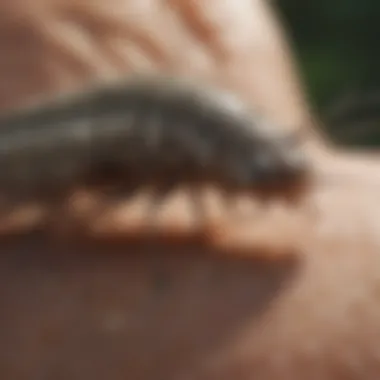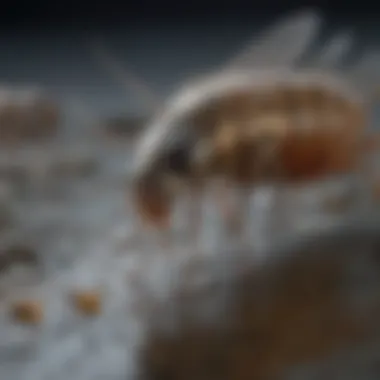Eradicating Silverfish: Effective Prevention and Treatment


Intro
Silverfish, small wingless insects, can be a nuisance in homes. They thrive in moist environments and consume various materials. Their presence not only indicates a moisture problem but may also lead to damage to valuable items such as books, wallpaper, and clothing. Understanding how to identify, prevent, and eradicate them is crucial for maintaining a pest-free living space.
This article offers a thorough exploration of silverfish infestations. It will guide homeowners through recognizing the signs of an infestation, practical prevention strategies, and treatment options that can effectively manage this pest.
Pest Identification
To manage silverfish effectively, proper identification is essential. These pests are typically slender, measuring about 12 to 19 millimeters long. They have a silvery-grey coloration, covered with scales that contribute to their shiny appearance. Silverfish move quickly, often evading direct observation, which can complicate identification.
Detailed Descriptions of Common Pests
Alongside silverfish, other pests might populate similar environments. However, they are distinct:
- Silverfish: Silvery-grey, flattened body, long antennae, and three long bristles at the end.
- Firebrats: Similar look but with a mottled brown appearance. They favor higher temperatures.
- Booklice: Small, soft-bodied insects that affectionately feed on mold and mildew.
Signs and Symptoms of Infestations
Detecting a silverfish infestation often requires vigilance. Common signs include:
- Damage to Paper Products: You may notice irregular holes in pages or textiles.
- Yellow Stains: These may appear on carpets or clothing due to their waste.
- Skin Shedding: As they grow, silverfish leave behind shed exoskeletons.
- Presence of Droppings: These are tiny and dark, resembling pepper flakes.
Silverfish prefer dark, humid areas. Bathrooms, basements, and kitchens are prime spots for their activity.
Prevention Strategies
Once identified, prevention becomes crucial. Addressing underlying issues within the home can minimize the chance of infestation.
Home Maintenance Tips for Pest Prevention
Simple maintenance can deter silverfish from settling in:
- Control Humidity: Use dehumidifiers or air conditioning to keep levels below 50%.
- Seal Cracks and Crevices: Inspect and seal entry points around windows and doors.
- Store Items Properly: Use airtight containers for food, papers, and textiles to reduce food sources.
Natural Deterrents and Barriers
In addition to general maintenance, consider these natural deterrents:
- Essential Oils: Citrus or peppermint oils can repel silverfish.
- Diatomaceous Earth: Sprinkle this powder in areas where silverfish are spotted.
Treatment Options
If a silverfish infestation occurs, it is vital to choose the right treatment strategy. Options range from chemical treatments to natural remedies.
Overview of Chemical vs. Natural Treatments
Chemical treatments may provide faster results but often pose risks. On the other hand, natural treatments may require more time but are typically safer for homes with children and pets.
Step-by-Step Guides for DIY Treatments
To address silverfish without professional help, consider these methods:
- Boric Acid Treatment: Mix sugar with boric acid and place it in areas of activity.
- Traps: Use commercial traps or create simple ones with soapy water in a dish.
- Vacuum Regularly: Regularly vacuum infested areas to remove eggs and specimens.
Understanding Silverfish
Understanding silverfish is essential for homeowners seeking to maintain a pest-free living environment. This section focuses on the biological aspects and behaviors of silverfish, which are critical for effective identification and management. Knowing the specifics of their biology and life cycle helps in formulating both preventive measures and eradication strategies.


These pests are not just unsettling; they can cause damage to personal belongings. Learning about their traits and preferences can empower homeowners to act decisively. Awareness of silverfish behavior also informs potential infestation signs and effective response actions. Therefore, this section lays the foundation for a holistic approach to managing these pests.
Biology and Anatomy
Silverfish are small, wingless insects characterized by their elongated bodies and silvery-grey color. They typically grow to about 1 to 2 inches in length. The body is covered with scales that give them a lustrous appearance. Notably, silverfish possess three long, bristle-like appendages extending from their rear.
Their anatomy is adapted for life in damp, dark environments. They have two long antennae, which enhance their tactile perception, thus allowing them to navigate their surroundings effectively. With their unique adaptations, silverfish can survive in various conditions, making them challenging to eliminate.
Life Cycle of Silverfish
The life cycle of silverfish comprises three stages: egg, nymph, and adult. Female silverfish lay eggs in hidden, moist areas, often in clusters. A single female can produce up to 100 eggs during her lifetime. The eggs hatch into nymphs, which resemble small adults.
Nymphs grow gradually, undergoing multiple molts before reaching full maturity, usually taking several months. This slow growth and reproduction rate contributes to their persistence in homes. Understanding this cycle is crucial for determining the timing and methods of eradication.
"Recognizing the life cycle of silverfish aids in effective pest control, targeting them at vulnerable stages."
Behavioral Patterns
Silverfish are nocturnal creatures. They tend to emerge at night, searching for food and moisture. Their diet primarily consists of carbohydrates, including starch and sugar found in household items. This diet leads them to thrive in areas like kitchens, basements, and bathrooms.
They prefer dark places, often seeking out cracks, crevices, and under furniture. Understanding their habits can help homeowners identify potential hiding spots, increasing the chances of effective control measures. Additionally, their ability to evade detection means regular monitoring is key to early intervention.
Identifying Silverfish Infestations
Identifying silverfish infestations is crucial for any homeowner or renter. Recognizing silverfish at an early stage helps to minimize damage. These pests can cause a range of issues, from damaging books and wallpaper to potentially ruining clothing. Understanding how to identify their presence significantly contributes to effective management, allowing for prompt intervention and prevention of extensive damage.
Common Signs of Infestation
Silverfish can be elusive, often hiding in dark or damp areas. Here are some common signs that indicate their presence:
- Visible Pest: Spotting a silverfish itself is a strong indicator of an infestation. They are small, about 1/2 to 1 inch long, and have a silvery-gray color.
- Droppings: The remnants left behind resemble tiny black pepper grains. Finding these droppings can signal that silverfish are active in your space.
- Damage: Look for holes, irregular shapes, or yellow stains on paper products. Silverfish primarily feed on items rich in carbohydrates and proteins.
"An early detection leads to more manageable solutions. Silverfish can reproduce quickly, escalating the infestation."
Types of Damage Caused
The damage caused by silverfish often goes unnoticed at first. However, it can become severe if left untreated. Common types of damage include:
- Destruction of Paper Products: Silverfish commonly consume books, magazines, and important documents. Their feeding creates small holes and can ruin valuable items.
- Damage to Fabrics: Clothing made from natural fibers, such as cotton or wool, may become targets. Silverfish can cause holes in clothing or other textiles in your home.
- Home Structure: In some cases, these pests can also cause damage to the interior of homes, mainly in moist areas like basements and bathrooms.
Differentiating from Other Pests
Recognizing silverfish from other pests is essential for proper treatment. Here’s how to tell silverfish apart:
- Appearance: Unlike cockroaches, silverfish are smaller and have a more elongated shape with long antennae. Their silvery appearance also sets them apart.
- Behavior: Silverfish prefer dark, moist areas, while other pests, like beetles or roaches, may be spotted in living areas.
- Feeding Habits: Silverfish consume carbohydrates, especially starches found in paper and glue, setting them apart from other pests that might target stored food.
By understanding these signs and types of damage, homeowners can act quickly to alleviate silverfish infestations and preserve their living environment.
Preventive Measures
Preventive measures are the cornerstone of effective pest management for silverfish. These insects can be a persistent nuisance, finding their way into homes and causing damage to various materials. Adopting preventive strategies not only reduces the likelihood of an infestation but also creates an environment that is less conducive to silverfish. Homeowners and renters can benefit significantly from understanding and implementing these measures.
Implementing preventive actions can lead to significant long-term benefits. A pest-free environment contributes to overall health, protects valuable belongings, and reduces the need for extensive pest control treatments later on. It's critical to understand that prevention is often more effective than treatment.
Maintaining a Clean Environment
A clean environment is crucial in keeping silverfish at bay. These pests thrive in dirty, cluttered areas where food particles and moisture are abundant. Regular cleaning routines can minimize food sources that attract silverfish.
- Sweep and vacuum regularly. Ensure you cover all areas, especially corners, under furniture, and behind appliances.
- Wipe surfaces where food is prepared or eaten to remove crumbs and debris.
- Declutter spaces. Removing unnecessary items reduces hiding spots for silverfish. Consider organizing your space to make cleaning easier.


Keeping a clean home is not just about aesthetics but directly impacts the reduction of silverfish populations.
Sealing Entry Points
Sealing potential entry points is another effective preventive measure against silverfish. These pests can enter through tiny cracks and gaps, often unnoticed. By addressing these vulnerabilities, homeowners can significantly decrease the chance of an infestation.
- Inspect doors and windows for gaps. Use weather stripping or caulk to seal any openings.
- Check for cracks in walls and foundations. A suitable sealant can be applied to fill these gaps.
- Ensure that vents are properly screened to prevent silverfish from getting inside.
Taking the time to secure entry points helps create a barrier, protecting your home from a variety of pests.
Controlling Humidity Levels
Silverfish thrive in humid environments. Controlling humidity levels is essential in preventing their development and survival. These pests prefer damp conditions that can easily occur in bathrooms, kitchens, and basements.
- Use dehumidifiers in areas prone to moisture, particularly in basements and bathrooms.
- Ensure proper ventilation in rooms that generate humidity. Open windows when possible or use exhaust fans.
- Regularly check for leaks in plumbing and repair them promptly.
Maintaining lower humidity levels can significantly hinder the comfort and survival of silverfish.
Proper Storage Techniques
Proper storage techniques can also reduce the risk of silverfish exposure to your belongings. These pests are drawn to certain materials, making how and where items are stored critical for prevention.
- Use airtight containers for food items and dry goods. Glass jars or plastic bins with tight lids work well.
- Store clothes and fabrics in sealed bags. Keep them away from moisture and ensure they are clean before storage.
- Limit the use of cardboard boxes. Instead, opt for plastic bins that are less attractive to silverfish.
By adopting effective storage methods, you can safeguard your possessions while discouraging silverfish from nesting in your home.
Eradication Techniques
Eradicating silverfish involves a multifaceted approach that integrates various strategies and methods. This section discusses essential techniques crucial to eliminating these pests effectively. Silverfish, notorious for their resilience and ability to thrive in various environments, require careful consideration. Homeowners must employ a combination of chemical treatments, natural remedies, and professional services tailored to their specific situations.
Chemical Treatment Options
Chemical treatments are often considered the most direct approach to manage silverfish infestations. These products come in various forms, including sprays, powders, and baits. When selecting a pesticide, homeowners should look for those specifically labeled for silverfish control. Some commonly used chemicals include:
- Boric acid: This is effective both as a contact insecticide and a stomach poison.
- Pyrethroids: Synthetic chemicals that disrupt the nervous system of insects.
- Insect growth regulators (IGRs): These disrupt the life cycle of silverfish, preventing them from maturing and reproducing.
When using any chemical, it is crucial to follow the manufacturer's instructions closely. Safety precautions should also be taken, especially in homes with pets or children. The benefits of chemical treatment include quick results and the ability to reach hidden infestations, making them a favored option for many homeowners.
Natural Remedies and Solutions
For those preferring a less chemical-intensive approach, several natural remedies may help control silverfish populations. These solutions are generally safer for households, pets, and the environment. Some effective options are:
- Diatomaceous earth: A natural powder that can desiccate silverfish upon contact.
- Essential oils: Oils like lavender or peppermint may deter silverfish when sprinkled or sprayed in affected areas.
- Cedar shavings or wood: Silverfish are known to dislike cedar, so placing shavings in storage areas can help prevent infestations.
Natural solutions offer a gentle yet effective means of management. However, they may require more time to yield noticeable results compared to chemical options. Regular application and a combination of methods often provide better success against silverfish.
Professional Pest Control Services
In some cases, homeowners may find that they cannot manage silverfish infestations on their own. Professional pest control services can bring expert knowledge and tools to the table. These services typically assess the situation comprehensively, identifying infestation sources and providing tailored strategies. Benefits of hiring professionals include:
- Expertise: Trained technicians can accurately assess the severity and source of the infestation.
- Custom treatment plans: Solutions that fit your specific home and infestation level.
- Ongoing maintenance: After treatment, professionals can offer recommendations and follow-ups to keep the pests at bay.
Choosing a reputable pest control service is vital. Look for those with positive reviews and experience related to silverfish management. In many instances, professional services can ensure a thorough eradication that homeowners may struggle to achieve independently.
Combining chemical treatments, natural solutions, and professional services often yields the best result in managing silverfish successfully.
By employing an appropriate eradication technique, homeowners can reclaim their homes from silverfish. Each approach has its merits and can suit different preferences and situations closely. Understanding these techniques enables homeowners to make informed decisions that align with their needs and comfort.
Post-Eradication Strategies


After successfully addressing a silverfish infestation, it is critical to implement effective post-eradication strategies. These strategies not only help ensure the pests do not return but also promote a healthier living environment. Focusing on monitoring and long-term management practices is essential. Through consistent application of these strategies, homeowners can safeguard their homes against future infestations.
Monitoring for Recurrence
Monitoring for recurrence entails regular inspections of the home for signs of silverfish. This practice is vital for early detection of any returning or new infestations. Some key points to consider include:
- Regular Inspections: Schedule bi-weekly checks in areas where silverfish were previously found. Pay close attention to damp places like basements, kitchens, and bathrooms.
- Use Traps: Setting up sticky traps can help monitor silverfish activity. If traps catch silverfish, it signals the need for further action.
- Document Findings: Maintain a record of when and where silverfish appear. This information helps in identifying patterns or potential problem areas.
"Regular monitoring is your first line of defense against recurrence."
By being proactive, you empower yourself to address issues before they escalate. Simple strategies like these make a significant difference in keeping these pests at bay.
Long-Term Management Practices
Long-term management practices reinforce the efforts made during eradication. They aim at fostering an environment that remains inhospitable to silverfish. Some practices include:
- Maintain Low Humidity: Since silverfish thrive in high humidity, consider using dehumidifiers or ensuring proper ventilation in damp areas, especially during humid seasons.
- Seal Entry Points: Regularly check and seal cracks or gaps in walls, door frames, and window frames. This greatly reduces potential entry points for pests like silverfish.
- Storage Practices: Store food in airtight containers and keep papers and books in dry, well-ventilated spots. Avoid leaving clutter and piles of materials that retain moisture.
- Regular Cleaning: Implement a regular cleaning schedule that includes sweeping and dusting to eliminate potential food sources for silverfish.
This holistic approach not only addresses the immediate issue but also promotes an ongoing pest-free environment. Combining these methods gives homeowners a robust defense against the persistent nature of silverfish.
Common Myths About Silverfish
Understanding common myths that surround silverfish is critical in addressing their infestations effectively. Many individuals hold misconceptions about these pests, often leading to ineffective handling methods. This section aims to clarify those myths, providing homeowners and renters with accurate information to manage their environments proactively. The importance of debunking these myths cannot be overstated; doing so alleviates unnecessary fears and paves the way for practical solutions.
Debunking Popular Misconceptions
Myth 1: Silverfish only eat paper.
While silverfish are attracted to carbohydrates found in paper, they actually consume a variety of materials. This includes grains, book bindings, and even glue. Therefore, believing they are only a concern for book lovers is misleading. Homeowners must recognize a broader range of potential damage.
Myth 2: Silverfish can seriously damage your home.
In general, silverfish do not cause the same level of damage as other pests like termites. Their feeding habits are less aggressive, and while they may cause some issues, they are not a structural threat. Conclusively, the alarm about their potential destruction is somewhat exaggerated. However, they can harm books and certain fabrics, leading to a nuisance.
Myth 3: Silverfish are only a problem in old homes.
This is false. Silverfish can thrive in any environment that provides dark, damp conditions, making them common in both new and old structures. Thus, both new house owners and those in historical properties need to consider preventative measures.
Understanding Their Role in the Ecosystem
Silverfish play their part in the ecosystem, despite being labeled as pests. They primarily feed on decaying matter, aiding in decomposition. This position in the food chain contributes to soil health. Thus, they do have some ecological value despite their unwelcome presence in human spaces.
House owners should consider the importance of balance. Eliminating silverfish entirely may upset local ecosystems. Instead, a controlled approach that emphasizes prevention and management allows them to coexist without causing harm.
In summary, addressing these myths and understanding the actual role of silverfish leads to better management strategies.
By acknowledging the realities, those dealing with these pests can make informed decisions regarding eradication and prevention strategies.
Finale and Key Takeaways
In summary, managing silverfish infestations is crucial for maintaining a healthy and safe living environment. This discussion on effective strategies and considerations provides homeowners with the knowledge needed to tackle this common pest. From identification, prevention techniques, to eradication methods, every step plays a role in minimizing risks associated with silverfish.
Understanding silverfish biology and behavior is vital. By recognizing signs of infestation early and establishing preventive practices, homeowners can significantly reduce the chances of an outbreak. This proactive approach not only protects property but also promotes peace of mind.
Moreover, resources are varied. Utilizing both chemical treatments and natural remedies offers flexibility based on individual preferences and health considerations. When considering pest control, professional services provide expertise, especially in severe cases. This may sometimes be the best choice for home protection.
Establishing long-term management practices is essential in the future. Homeowners should remember the significance of routine inspections and environmental controls. Humidity control, proper storage techniques, and regular cleaning practices contribute to a pest-resistant home. With commitment and the right strategies, homeowners can eradicate silverfish once and for all.
Summarizing Effective Strategies
To effectively deal with silverfish, here are key strategies to remember:
- Identify early signs of infestation, such as yellow stains or shed skins.
- Maintain a clean environment, as clutter provides hiding places.
- Seal potential entry points to block future invasions.
- Control humidity levels to discourage silverfish as they thrive in moist conditions.
- Utilize both chemical and natural treatments, observing safety guidelines where necessary.
- Consider hiring a professional pest control service for significant infestations or ongoing issues.
Future Considerations for Homeowners
As you continue managing your home, consider these future obligations:
- Stay informed: Keep up with the latest pest control methods and research.
- Routine inspection: Schedule regular checks, especially in attics and basements.
- Environment maintenance: Ensure proper ventilation, and consider dehumidifiers if necessary.
- Storage solutions: Use airtight containers to protect food and paper products.
Remember, prevention is the key to successful silverfish management. By staying vigilant, you protect your home and enhance your living standards.
By embracing these measures, homeowners empower themselves against silverfish. A proactive stance fosters a pest-free environment, aiding not just in comfort but also in safeguarding property value. Educating oneself and applying effective strategies ensures ultimate control over these resilient pests.



